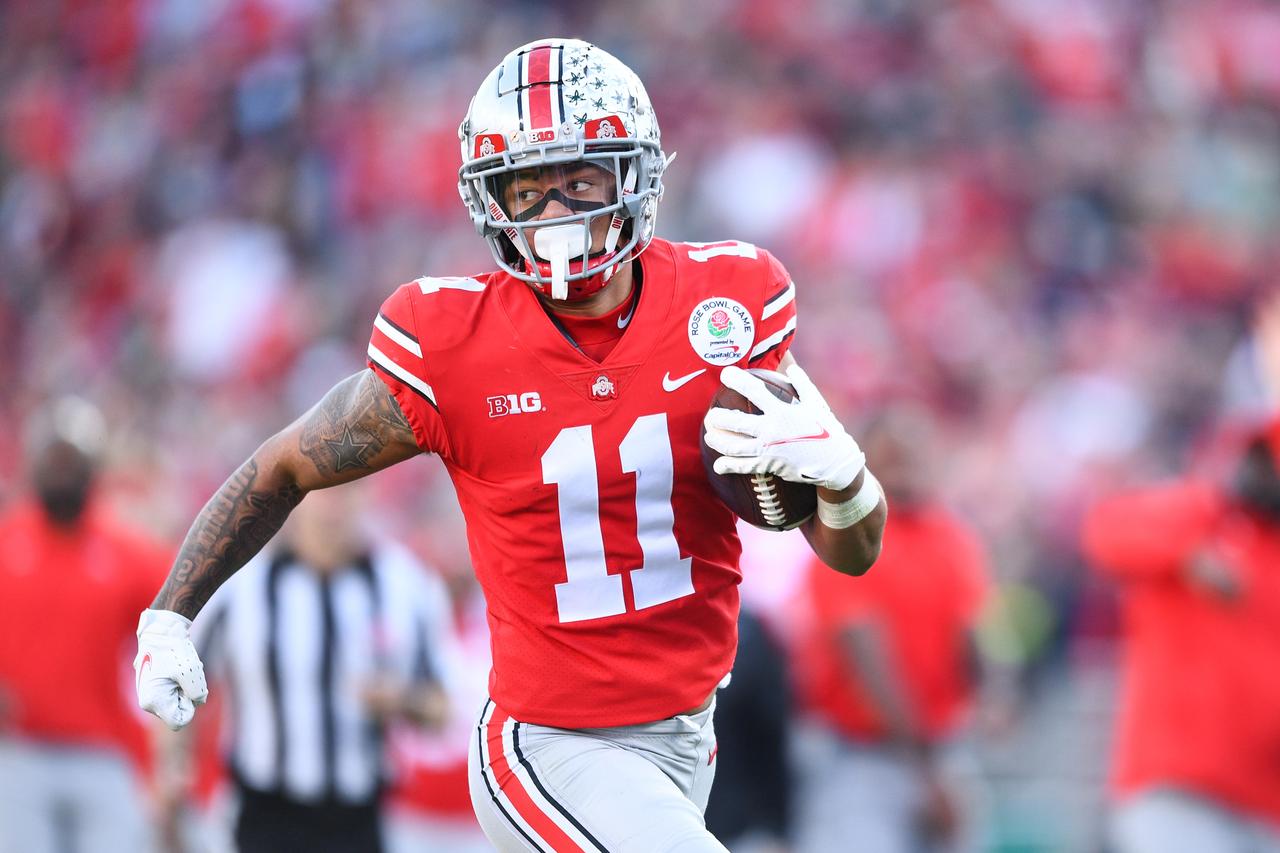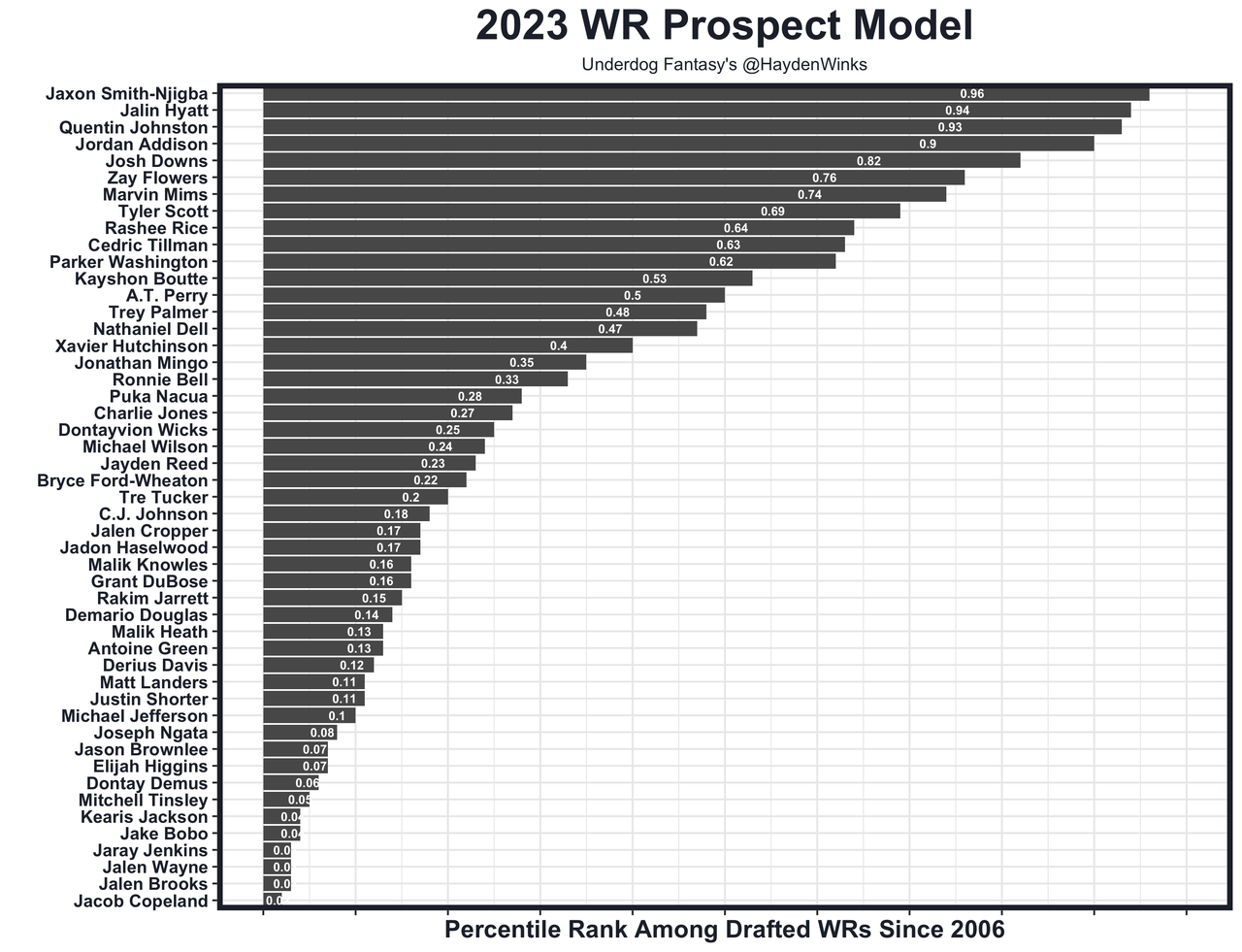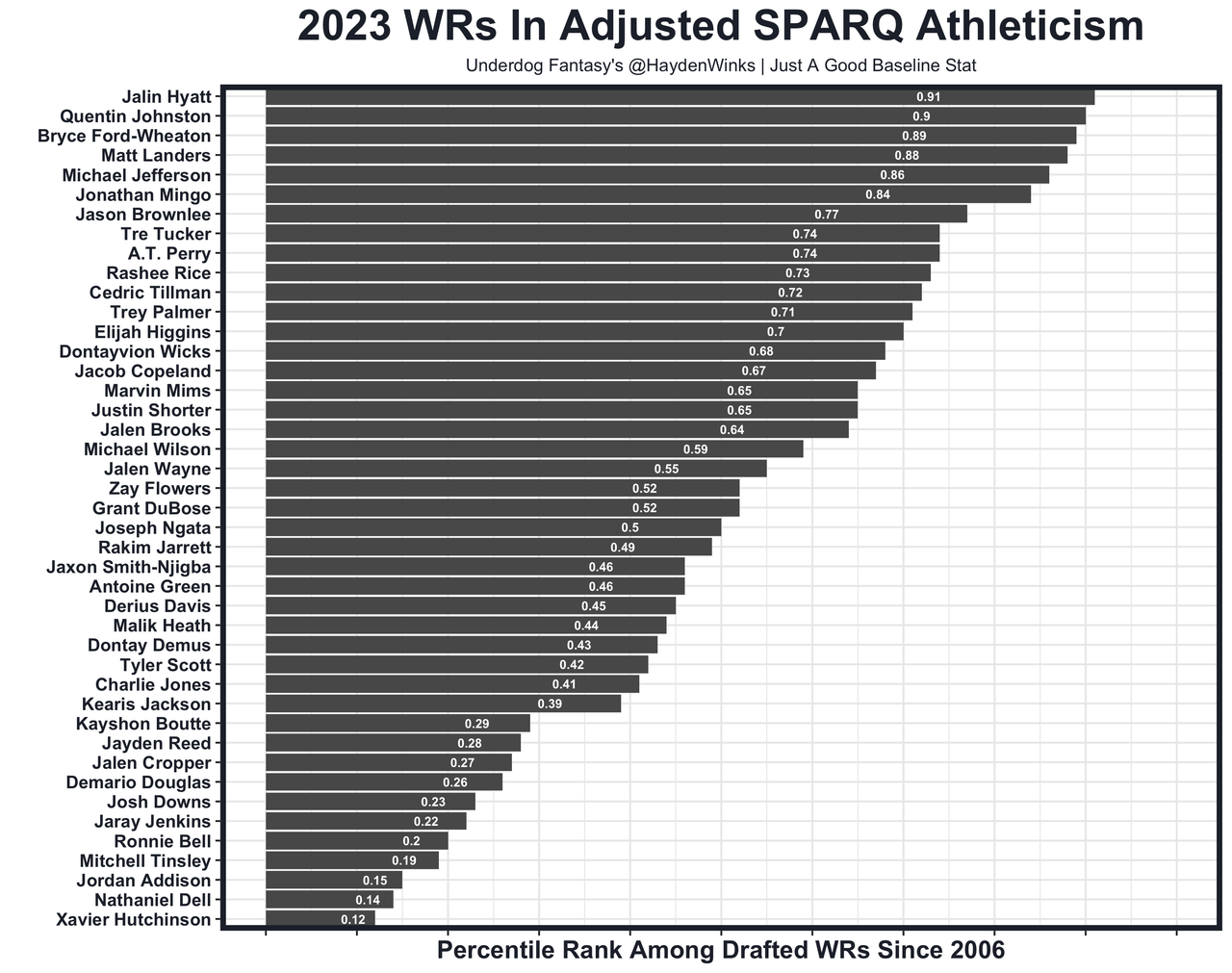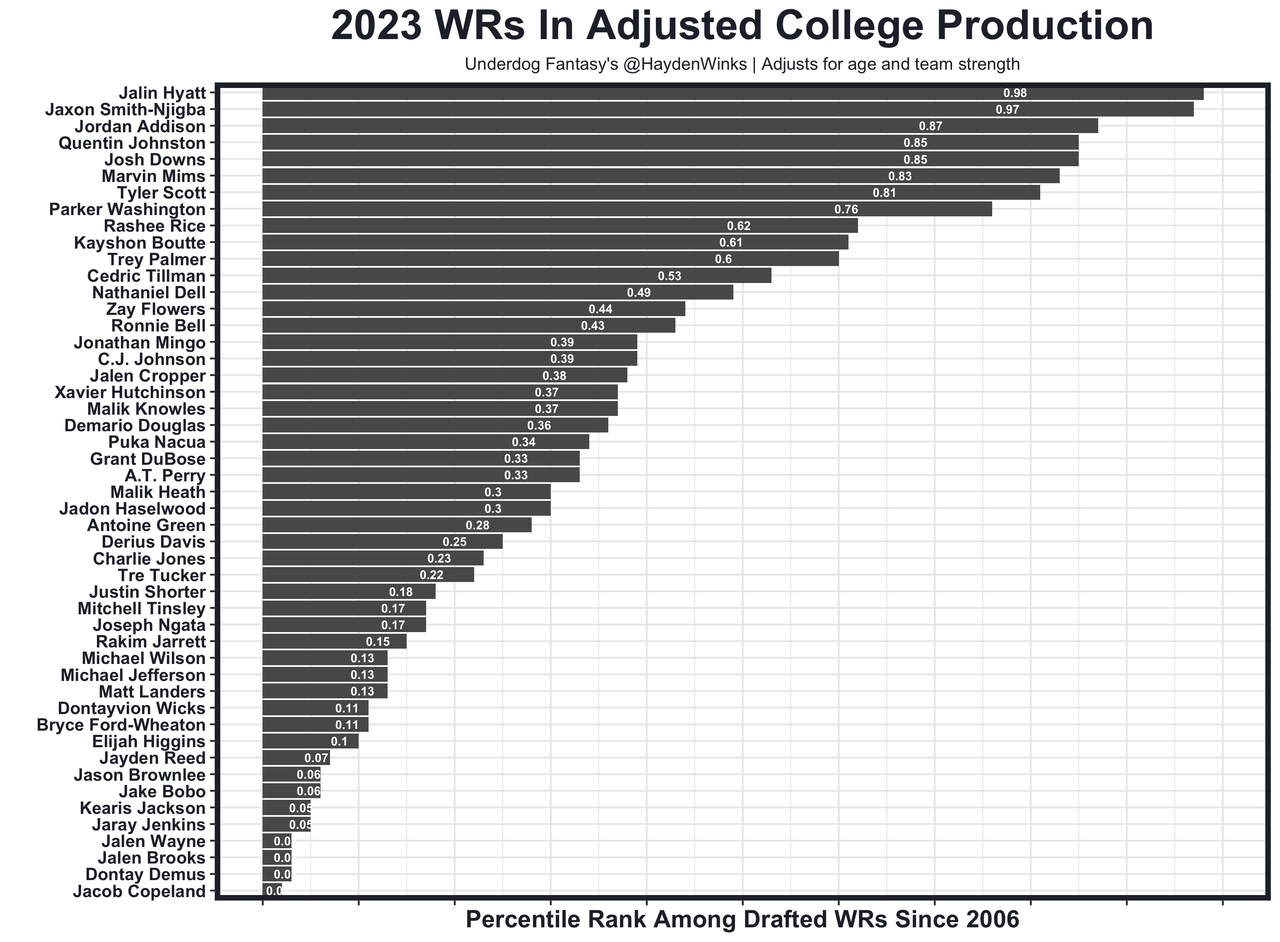2023 NFL Draft WR Rankings, Grades, and Profiles

2023 NFL Draft wide receiver rankings, grades, profiles, analytics, and film notes for the consensus top-6 WR prospects -- Jordan Addison, Jaxon Smith-Njigba, Jalin Hyatt, Quentin Johnston, Josh Downs, and Zay Flowers. Hayden Winks drops his early looks at each prospect, with more notes coming as we get closer to the 2023 NFL Draft.
If you agree or disagree with these takes, you should go to Underdog Fantasy and play in our $1 MILLION fantasy football tournament that features the entire 2023 rookie class. That contest will close well before the draft begins, so go to the lobby now. Promo code 'underblog' gets you a $100 deposit match bonus. You'll love it.
1. Jaxon Smith-Njigba (Draft Grade: Mid Round 1)
In 10 games with first-rounders Garrett Wilson and Chris Olave, Smith-Njigba averaged 19.2 PPR points per game to their 22.9 and 21.8 points. That’s impressive. And then he went nuclear (15-347-3) in the Rose Bowl with them sidelined, bringing his 2021 seasonal average to 124 yards per game on an elite 4.0 yards per route run. That’s a 95th percentile final season among drafted WRs since 2005. He played in the slot on 88% of his snaps, with just six routes in 1- or 2-WR sets per Sports Info Solutions. Six!!! His skill set aligns with a primary slot profile, too.
Smith-Njigba has a good feel for zone coverage and is a nasty route runner on underneath routes. He plays with a methodical pace to create separation and was moved into the backfield or in motion to give him space (both a pro and con), similar to Amon-Ra St. Brown. In fact, 19 of his catches came off pre-snap motion. His hand-eye coordination and ball skills are quite impressive on slot fades. He comes back towards the ball on underneath routes so corners don't crawl over his shoulder. But he’s not an explosive athlete, neither with long speed nor with jumping. He will be chased down after the catch, somewhat limiting his peak ceiling and likely keeping him inside on most NFL snaps. If healthy (he missed his entire junior year with a hamstring), Smith-Njigba has the upside to catch 100+ passes in his prime, even if there are some physical weaknesses. He’s that good of a route runner, and his short-area agility is elite with a 98th percentile three cone. I compare him to Julian Edelman, who had six-straight seasons of 66-76 yards per game. His pure ceiling comparison is Cooper Kupp, who is slightly taller and stronger... My model: 96th percentile.

2. Jordan Addison (Late Round 1)
As a true freshman, Addison led Pitt in receiving, and then he followed it up with a Biletnikoff Award season (1,649 yards and 18 TDs) with Kenny Pickett before transferring to USC. That would’ve been a 94th percentile final season in PPR points per game among drafted WRs since 2005. He battled injuries as a Trojan but still managed to average 87 yards per game on 2.8 yards per route run before declaring early. His slender frame (6’0”/178) is a concern but can be worked around. He played in the slot on 68% of his snaps in 2021 but played more outside (76%) under Lincoln Riley, who still put Addison in space by throwing him 26 screens. When he wasn’t designed those screens, he operated as an intermediate and deep threat. All blades of grass are open to him.
Addison is a hit-and-miss athlete. He’s bendy and fluid, with impressive body control. That shows up most in the red zone, near the sideline, on whip routes, and with his impressive press-man coverage releases. Sports Info Solutions had him with 4.4 yards per route against man coverage (very good) because he creates separation at his breaks. His fluidity and ability to work in CB’s blind spots make him a threat on posts and digs, despite his sub-average speed. His 4.48 forty is in the 39th percentile and is far worse when weight adjusted. Same with his 23rd percentile vert. Others will handle physicality better and his length isn’t on a DeVonta Smith level, but NFL rules and offensive designs are hiding Addison’s primary weaknesses. He’ll win inside and out, with more YAC skills than given credit for (7.0 yards after the catch average). His upside comparisons are CeeDee Lamb, Stefon Diggs, and Calvin Ridley, but the range of outcomes is wide, as his physical profile isn’t one of a first rounder. Perhaps Biletnikoff Award Darnell Mooney or a more polished Diontae Johnson are more appropriate. The tape and his on-field production are carrying his grade... My model: 90th percentile.
3. Jalin Hyatt (Round 2)
After 20- and 21-reception seasons, Hyatt (6’1”/185) broke out as a true junior with 1,287 yards and 15 touchdowns on just 67 receptions as the Vols’ primary deep threat from the slot and Z spots. His 23.8 PPR points per game are in the 88th percentile among drafted WRs since 2005. He led college football in yards and EPA in 3-WR sets per Sports Info Solutions, thanks to an absolutely wild 7.2 yards per route run on deep routes (posts, corners, go, back shoulder, double moves, crosses, and seams). Against man coverage, he averaged 3.5 YPRR, though most of it was off coverage. He rarely faced press man because HC Josh Heupel protected Hyatt by putting him in stacked formations, in the slot (87% snaps), and in pre-snap motion (12% of his receptions). In fact, he only had 19 routes as the isolated WR and only three routes in 1- or 2-WR sets. Three!!! He also didn’t face man because defenses respected his 4.40-forty speed. After hanging 6-207-5 on Alabama, the Georgia defense routinely played Hyatt 10 yards off the line of scrimmage.
Hyatt will be a No. 2 or No. 3 WR and deep threat in the NFL. He only had one career game with 8+ receptions, and his average depth of target likely lands around the 14.1 yards downfield that it was in college, where he can use his speed to threaten defenses vertically. He can be thrown off his route fairly easily given his size, so going to an offense that can protect him will be key. Tennessee’s offense did that beautifully. That leaves him with a lower floor given the wild transition between systems, but he’s also a 21-year-old early declare with the frame to continue adding some weight. His interviews are awesome, too. He clearly knows ball and is a film nerd. Hyatt is on the Will Fuller, Marquez Valdes-Scantling, T.Y. Hilton, and Nelson Agholor plane... My model: 94th percentile.

4. Quentin Johnston (Round 2)
A 4-star recruit, Johnston (6’3”/208) led the Horned Frogs in receiving in all three seasons before declaring early. He averaged 14.5 PPR points per game (39th percentile among drafted WRs since 2005) with 2.5 yards per team pass attempt (62nd percentile) and 3.0 yards per route run during TCU’s National Championship run. He moved around the formation but looks like a traditional X-WR, with a decent 3.2 yards per route run versus man coverage per Sports Info Solutions. His best routes are in a straight line, where he averaged a very strong 5.3 yards per route run on deep routes (posts, corners, nines, back shoulders, double moves, deep crosses, and seams). He’s a size and speed player with just enough wiggle to throw him an occasional screen; 25% of his junior receptions were screens. That’s a lot.
Johnston will threaten defenses vertically as a perimeter player, but he’s still in development as a 21-year-old early declare. His hands need work. He body catches everything and doesn’t high-point passes despite playing in a Mike Williams like role, leading to a way-too-high 11.8% drop rate. While he does have size-adjusted speed, he can be a little clumsy. At the top of his routes, he often falls down or allows corners to get hands on his big frame, which also plays into his drop problem. Most of his production against Michigan came against failed blitzes, his Georgia tape versus NFL CBs was very troubling (3 yards), and he did play in the Big 12 where receiving stats are historically less translatable. He only had four games with 6+ receptions and best projects as a No. 2 or No. 3 receiver who can be moved from X-WR back into the slot. He’s on the Martavis Bryant, Christian Watson, Treylon Burks, Chase Claypool, and Denzel Mims plane, though his ceiling could be higher if his yards after catch skills are better than I have given him credit for... My model: 93rd percentile.
5. Cedric Tillman (Late Round 2)
A 23-year-old redshirt senior from Tennessee, Tillman has an atypical statistical profile but has the wide receiver traits that are hardest to find. He broke out as a redshirt junior in 2021, averaging 90 yards per game on 86th percentile yards per team pass attempt. He didn't declare and immediately injured his ankle (requiring surgery) in 2022. The Vols' offense is very spread oriented, but Tillman ran real routes and lined up on the line of scrimmage, sometimes in isolation, as a legit X receiver. His average depth of target was 15.8 yards downfield, where he can win with some deep contested catches near the boundary. His speed is below average, however. He ran a 4.54 forty, but his 6'3"/213 frame and 82nd percentile broad jump are a promising combination for the role he'll be playing in the NFL.
Tillman is a physical player, capable of battling against press man coverage. He can shield corners on in-breaking routes and high-point deep passes. He's not a major yards after catch threat but can fight for extra yards in tight spaces. He moved around the formation, including in bunch sets where he shows off high levels of dog in the blocking department. He might be the best blocking receiver in the class. He's maxed out given his age, but this physical X-receiver and dirty work loving skillset is hard to find, as the position overall gets smaller. I compare him to Corey Davis, Michael Gallup, Courtland Sutton, and Nico Collins, despite his overall profile being weaker. The tape is there, and he should be a 2-WR starter if his ankle is okay... My model = 64th percentile.
6. Zay Flowers (Late Round 2)
A former 3-star recruit from Florida, Flowers (5’9”/182) was a four-year contributor in Boston College’s horrific offense, operating as an inside and outside receiver. He had 1,117 yards and 12 TDs as a senior, good for 62nd percentile PPR points per game among drafted WRs since 2005. That was his lone 1,000-yard season. He was schemed passes underneath (14 screens) but mostly worked as a vertical playmaker. 33% of his snaps came in the slot, where he can work on slot fades and up the seam rather than as an option route runner. His ball tracking skills and body control downfield are very good for a player with his frame, but only 17 WRs in NFL Combine history have had his 29.25-inch arms, making him an anomaly projecting him for an outside and vertical role. He makes it up with incredible dog levels, which can show up after the catch on crossing routes and backfield pop passes.
Flowers plays quickly in all capacities, which has led to a too-high 10% drop rate and some chaotic routes. He loves to hit CBs with whip routes and double moves, particularly running many out-and-ups. But he lacks patience working through zone defenses and setting up shorter routes like slants. His 2.4 yards per route run against man coverage is average, though his quarterback certainly held him back. To round out his game, he needs to work on pace because he’s maxed out athletically following a big bulk cycle heading into the NFL Combine. He ran a 4.42 forty, which matches his good not great straight-line speed on go balls. Ultimately, Flowers looks like a poor man’s Antonio Brown but likely plays closer to smaller versions of Christian Kirk or Jahan Dotson as a vertical slot and No. 2 or No. 3 receiver... My model: 76th percentile.
7. Jonathan Mingo (Late Round 2)
Through four years at Ole Miss, Mingo never led his own team in receiving yards, but he did have games of 8-116-2 and 6-136-1 early in his junior season before breaking his foot in practice going into Week 4. It's possible that injury is hiding a better overall prospect. On tape, he provides a physical presence from all receiver spots. In fact, he'd be used in bunch sets and as a tight end in some running downs to showcase his excellent run blocking skills. As a receiver, he's not a smooth separator, but he can surprise after the catch with plus athleticism. He is an 84th percentile adjusted SPARQ athlete with and 84th percentile weight-adjusted forty (4.46) and 85th percentile jumps. That burst on his 6'2"/220 frame gives him stylistic comparisons to Deebo Samuel and A.J. Brown.
His QB left major big plays on the field, but the difference between those SEC stars and Mingo is production. He only had 3.9 receptions per game, leading to 38th percentile PPR points per game and 18th percentile production when adjusting for age (22-year-old senior) and team strength. He's tight in his movements at all three levels, rather relying on straight-line athleticism. There aren't many size and speed freaks in this draft class, so Mingo has more upside than most on Day 2... My model = 35th percentile.
8. Josh Downs (Early Round 3)
Downs (5’9”/171) was a 4-star recruit with two 1,000+ yard and 90+ catch college seasons before declaring early. His 19.6 PPR points per game checks in the 89th percentile among final collegiate seasons of drafted WRs since 2005. He is a traditional slot receiver with an 8.8 average depth of target. He maneuvers underneath routes with diverse pacing and has a great feel for zone defenses, allowing him to catch an absurd 43% of North Carolina’s passes as a true sophomore. He creates separation on option routes and will occasionally win a contested catch on a slot fade. His long speed is average (48th percentile forty) and other slot-only receivers can get out of their breaks quicker, but he offers short-area burst. His 10-yard split and broad jump were both above the 92nd percentile.
A 21-year-old analytics darling, Downs profiles as a starting slot but likely has a capped ceiling in a similar mold of Hunter Renfrow. In a 3-WR set offense with a check down QB, he can catch 75-100 passes given his reliable hands (3% drop rate) and football IQ. He had the best film breakdowns of the WR interviews I’ve come across and will likely be a QB’s safety blanket. Unlike other volume hogs, only 11-of-94 junior receptions came on screens or jet sweeps. He earned his looks. His 2nd percentile weight, below-average yards after catch numbers, and long speed are the lone concerns. He has 36th percentile adjusted SPARQ athleticism, when accounting for weight. I compare him to Randall Cobb, who was loved by his QBs despite middling physical traits... My model: 83rd percentile.

9. Tyler Scott (Early Round 3)
A 21-year-old early declare, Scott (5'10"/ 177) is an ascending deep threat with just three years of wide receiver experience, following his days as a running back in high school. He began his collegiate career as a punt gunner on Cincinnati's special teams, before mixing in as a speedster while a sophomore. His breakout season came last year, resulting in 81st percentile age and team adjusted production, 75th percentile college dominator rating, and 52nd percentile PPR points per game among draft WRs since 2005. He averaged 16.6 yards per catch (76th percentile), while lining up out wide on 96% of his routes, many of them as an X receiver in a pro offense.
Scouts rave about Scott's character and special teams effort, which will help him last in the NFL. He'll need that to shine while he develops his route running, strength, and 10% drop rate. Against man coverage, he only had a 1.5 yards per route run, partially because of his small frame and lack of experience. When given some space, Scott can get rolling and showcase his 4.4 speed. He can split safeties down the seam and be used behind the line of scrimmage. He has the body control to make acrobatic catches away from his body. It's possible Scott plays more inside in the NFL, while maintaining his downfield threat. There's grooming time needed, but I compare him to an unpolished Jahan Dotson... My model = 72nd percentile.
10. Marvin Mims (Round 3)
A 21-year-old early declare from Oklahoma, Mims checks a lot of sleeper boxes if he can continue his development. He has punt returner experience, and that style translates to how he plays receiver. He played in the slot on 45% of his snaps throughout college but as a vertical threat where his straight-line speed shines and his slender frame (5'11/183) is easier to hide. His 20.1 yards per reception rate as a junior clocks in at the 95th percentile among drafted receivers since 2005. His overall production is in the 83rd percentile when adjusting for age and team strength. He only averaged 4.2 receptions per game, leaving him with 44th percentile PPR points per game. Mims (65th percentile adjusted athleticism) ran the forty in 4.38 seconds, and he had 85th percentile jumps. The tape confirms. 56% of his yards and 100% of his touchdowns came on targets 20+ air yards downfield, as most of his routes are of the deep variety.
He will stress deep safeties, especially when off the line of scrimmage from the slot or at Z, but he can go quiet for stretches because of Oklahoma's odd offense and because his straight-line athleticism isn't as effective on underneath routes. Oklahoma had him running a lot of option routes, so there were dozens of routes that just don't translate to the big leagues. He also did a lot of different things for the offense, hurting his chances of dominating in one phase. In addition to having a better feel for zone and breaking routes versus man, he needs to improve his strength. He can be tossed around after the catch, while blocking, and at the top of his routes. Expect him to contribute in the return game while competing for a clear-out No. 3 receiver role in the slot or out wide. Long term, I compare him to Darius Slayton or Darnell Mooney, but the development could take longer than the dynasty community expects based on his statistical profile... My model = 74th percentile.